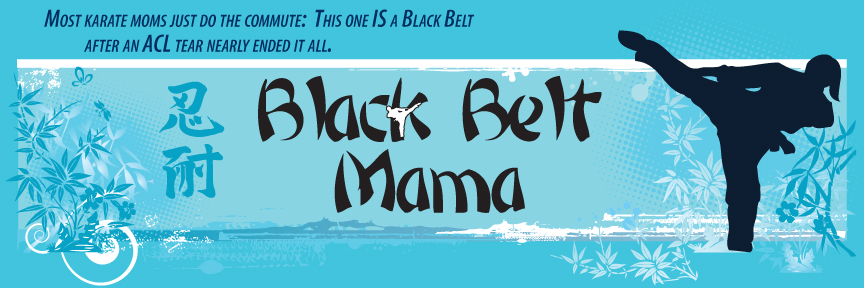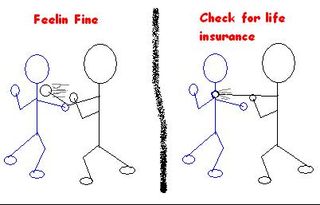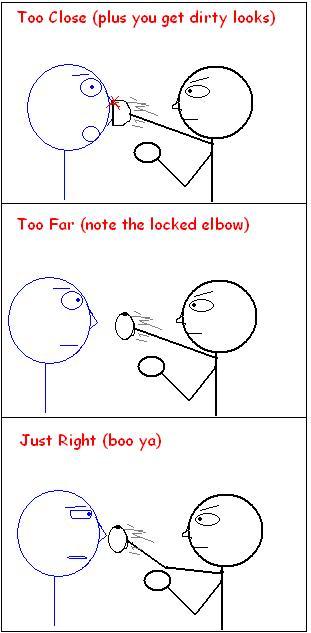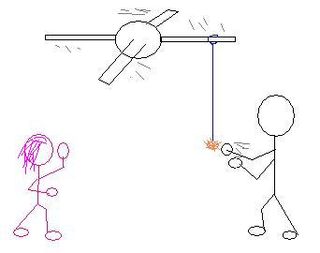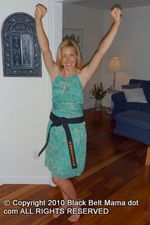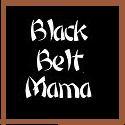Self Defense Advice from a Pioneer
In 1975 I was in college. There was a notice posted about a Women's Self Defense course being taught in the auditorium. At the time I had just started training and was a yellow belt. I went to the program and there was a woman giving a lecture about self defense for women. She was an excellent speaker and I left there feeling empowered by what she said. I knew that someday, when I knew enough karate, that I wanted to teach women's self defense classes also.
Months later I was at a karate tournament. I noticed the only woman judge was the same woman that taught the self defense program at the college. There she was up on the ring with the men wearing a red and white belt. I didn't know what a red and white belt was. I am teaching my 29th Annual Women's Self Defense program this year. I still say the exact words that I heard in 1975 in that program at college.
That woman who taught me so much about women's self defense was Bobbi Snyder. I admire Bobbi Snyder for all she did for women in the art. She is the true Mother of Karate. She opened many doors and plowed the way for us to follow in her footsteps. I am honored to use her words in my classes.
Some of things she said are as follows.
She told us no one is with us 24/7 to protect and take care of us; it is up to us to defend ourselves. If you are confronted, don't expect anyone to run to your aid. No one wants to get involved. Never yell for help; no one will help you. Yell "fire" because everyone will run to see the fire. Don't be a quiet victim; yell and scream. Make a scene.
We must be aware of our surroundings at all times. Trust your gut instinct. That voice is there to protect you. When you meet someone, that first impression is 99.9% of the time correct. If you must strike someone, remember the three main target areas: eyes, knees and groin. Also remember that if they can't see you, they can't find you. If they can't run, they can't catch you. Survive and thrive.
Ms. Bobbi Snyder, age 72, passed away in August of 2008 in Pittsburgh, PA. Ms. Snyder was one of the first black belt women competitors in the United States Karate Organization in the 60's. At a time when all women were forced to compete together in one ring regardless of belt rank, and were not allowed to judge any ring, she fought for equality and stood up for women and men as well in all areas of martial arts.
***Leave a comment (or several) on any of the featured martial artists' posts during the month of March, and you'll be entered to win one of several great prizes. For details on the presented writers this month or for more information about the prizes, go here.
It’s Admired Martial Artists Month!
For new posts, please scroll down! Thanks for stopping by!
March is an exciting month here on Black Belt Mama. Not only will there be an exciting guest post from admired martial artists each week, but now there are also giveaway prizes from Martial Arts Supplies, Turtle Press, from Kyoshi Hayes, and from Bags of Character (and there may be others too)! For your chance to win, leave a comment on any of the posts featuring one of the Admired Martial Artists. The more comments you leave, the more opportunities for you to win! If you post the Admired Martial Artists button and link back here, you'll automatically get three additional entries! (Shoot me an email with the details.) Just click on one of the featured posts below (look for the banner) and leave a comment for your chance to win! For more details on the prizes, visit the Admired Martial Artists main page.
Admired Martial Artist Posts
The Importance of Control (Less Boring than it Sounds) by Sandan Matthew Apsokardu
Self Defense Advice from a Pioneer by Kyoshi Nancy Caliguri
Why a Kid Needs to Learn to Fail Successfully by Kyoshi Ann-Marie Heilman
There Are No Stances in Kobudo by Hanshi C. Bruce Heilman
Deepening the Way by Kyoshi Bill Hayes
What is Sometimes Hidden, You Oversee by Kyoshi Rick Zondlo
The Importance of Control (Less Boring Than It Sounds)
Hey BBM fans, it's my pleasure to hop over from my normal stomping grounds to kick off this month's guest posting. I have some amazing martial artists coming after me so I''ll try not to drop the baton too early (did that ever happen to anyone in high school during track and field day? Mortifying).
I'd like to talk about control today. It's not the sexy side of karate, but control is utterly critical to becoming a mature and successful martial artist. Sure, brick breaking and board snapping is much more impressive on the surface, but some of the most awe inspiring techniques I've seen in my life are the ones that dance the razor's edge of dispatching a live partner.
Power and Control In the Beginning
When first starting a martial art, everyone wants to learn how to hit powerfully. I know I did. In order to learn how to hit with force, one has to be taught good basic body mechanics and striking technique. Luckily, with the kinds of pads, heavy bags, and impact shields found in almost every dojo, this instruction is possible.
Although the martial arts are a very long term endeavor, the basics of proper hitting can be learned fairly quickly. In fact, a common concern for instructors is that students will learn how to hit hard before learning why. This is also one of the reasons that there are both shallow and deep levels of learning in karate. But more on that later.
A Turning Point For Every Student
After a few years of training, every student comes to a crossroad (one of many) where they have to actively decide to improve their control. Unfortunately, this is a narrow path with steep edges on either side.
On one side, you have individuals who are turned off by the thought of pulling punches. They feel that the only way to develop true power is to throw bangers all session every session.
On the other side, you have people who grow accustom to not hitting anything at all. They are comfortable snapping their punches 3-4 inches away from any target in the name of safety and good practice.
Sadly, both of these mindsets are limited. In actuality, proper control needs to be executed at the right distance at full speed. Consider this graphic:
In the first panel, we see an obvious problem as our wayward attacker makes contact with his partner. A punch to the nose is clearly problematic, but strikes that are too hard to any surface of the body can cause injury and distrust amongst fellow students.
The second panel is less dangerous, but just as concerning. The attacker has completed his technique far away from his partner (which you can tell by the full extension of the arm). Although no one got hurt, the attacker is practicing bad distancing and creating habits within himself that can cause issues when trying to use his techniques for real.
The third panel represents a properly executed practice punch. The fist came extremely close without touching, and the arm still has room to 'complete' the technique through the defender, driving the defender's nose and head backward.
Tips For Developing Control
The bad thing about control is that it takes awhile to develop. One thing I do not advise is going around your dojo and throwing full speed punches at people's faces, getting as close as possible until eventually you mess up. That is a quick way to become a dojo pariah. Instead, there are some drills and strategies you can employ to slowly build up your skill.
The first concept utilizes basic focus bags. When training your strikes, take time to practice your power techniques, but also try some controlled reps. See if you can kick and punch so that you are barely scraping the bag. Since no one can get hurt, don't let up on your speed, power, or proper body mechanics. Strike and commit as best you can while pulling the hit.
The second involves a live partner. Forget about face stuff for awhile and focus on the body. Using a relaxed fist, strike in at your partner's abs or chest (this is for control drilling, not vital target practice). Allow your loosened fist to touch your partner, and then retract. You should hear a slight snap of their gi as your light strike touches it.
You can also take your practice home with you. Get some light string and a balled up piece of paper. Attach the ball of paper to the string and hang it from a doorway or ceiling fan blade. The paper is very light, so you'll get a sense of how close you strike by watching the paper's slight movements (or not so slight if you mess up).
If your ceiling fan has a speed slider, or very slow setting, you can make this a game with your kids who might be involved in karate. Just make the fan spin slowly and take turns striking at the paper. It can be fun once someone messes up and the ball starts squiggling as it spins. As you can imagine, this is actually great practice for live sparring control.
Breaking the Glass Ceiling
Proper control isn't just for good dojo etiquette; it's actually critical for learning the deeper aspects of karate and other martial arts. While a punch to the solar plexus or nose is great, there are a ton of other techniques and targets that martial arts can offer.
Palm heel, ridge hand, ippon nukite, etc. + eye, ear, throat, groin, spine, etc. = very risky business.
If a practitioner's mastery of control is anything less than stellar, they'll be unable to utilize these techniques at full speed with the right distancing and timing. Their arsenal will always be limited in variety and effectiveness; they will always be stuck under a glass ceiling, no matter how hard they strike.
While most people think of sparring as the heavily padded event we see today, kumite without padding has been around for much longer. Without pads, karateka were free to target even subtle vital points on each other's bodies and utilize small joint locking tactics. Of course, the problem with sparring without pads is that there needs to be trust and expertise between both parties involved. If you've ever thrown a spear hand technique toward someone's eyes without them expecting it, you know just how strong a reaction some of karate's more vicious techniques can elicit.
Furthermore, most of what we see of kyusho (vital point striking) is done very statically. By that I mean one person stands quite still or throws a single predicted strike, while the uke performs whatever vital point technique he happens to be demonstrating. The reason behind this is both demonstrative and fear-based. Using kyusho without perfect control in a sparring setting can result in illness, injury, or death. Therefore, most kyusho training is done below the glass ceiling because it's too much of a liability to practice otherwise.
Without being completely comfortable using techniques at any range with any sized opponent, and being able to do so correctly, there will always be limits to what a person can learn and use. In other words (if you'll indulge me in this turn of phrase), it's the lightest strike that breaks the glass.
When Control Seeps Over
One of the true gifts of karate lies in the improvements we don't readily see coming. The control I've talked about today is physical. But, in order to train for control, one has to adopt a mindset of control. By making this psychological change, the focus of karate shifts from that of power and strength to reservation and focus.
Mental adaptation tends to be infectious in a very good way. Where emotional outbursts may once have been a natural reaction in every day life, karate's imposed control begins seep in. Furthermore, a person's spirit begins to exude restraint. When that happens, it becomes much clearer when to use karate and not just how. A body, mind, and spirit of control is one of budo. A person who can embody control is one who can follow the martial way.
* * *
Matthew Apsokardu is a 3rd Degree Black Belt in Okinawa Kenpo Karate/Kobudo and student of Muso Jikiden Eishin Ryu. He is also the author of Ikigai | Blogging the Martial Way. To read more from him, visit his website or leave him a message at mapsokardu AT gmail DOT com.
This just in! Admired Martial Arts month just got even more exciting! Anyone who leaves a comment on one of the Admired Martial Artists' posts during the month of March will be entered to win a giveaway prize courtesy of Martial Arts Supplies. Leave a comment on each post, and check back often. The more comments you leave, the more chances you have to win! More giveaways are in the works! For details, go here!
Where is my Mind? What am I Thinking? I Can’t Do This!
Filed under: Admired Martial Artists Month, Guest Post, Tales from the dojo
When I was asked to be a feature Martial Artist of the month, I thought, ohh boy…what am I going to write about? My experiences with transmitting information during class have gotten me some blank stares, sleepy eyes, yawns, and inquisitive faces…but most of all, a sense that I pulled the rug out from under their feet.
So I pondered the question and looked for something common that all martial artists go through in the beginning and while advancing through the ranks, even well into the Black belt Dan’s, so maybe I can provide a little enlightenment and not try to bore you with too much Japanese Terminology by doing it.
* * *
The class is milling about, the most Senior Black Belt or Sensei barks out the command " Narande" (line up) after Reishiki (Rei in and respects). The Sensei then tells the students what he is going to instruct in class that night, and the faces of students turn into that deep troubled look, like they left the stopper in the bathtub and forgot to turn off the water!
Whether it is Kata, Waza, Self Defense, or Weapons there is someone that is not going to like what’s in store for them that night. Mostly it is not that they dislike the techniques, it is that they have a difficult time executing what the Sensei wants them to do. So many times I hear, I can’t do this, I don’t how to move, I can’t seem to get any power, this manipulation escapes me, what am I suppose to be feeling, what should I look at, how should I react or act?
Lets look at one activity that makes many students cringe – Sparring. When Sensei barks out "pad up, Kumite," that demon opens the door and some cringe and mutter "oh no, not that," and some even start to make themselves ill, for they will have to deal with that one person or fear or the fact that they’re just not any good at sparring.
* * *
Mushin (no mind), Zanshin (alertive mind, or Warrior Spirit) – these are the building essentials that will help you break through fear and mold you on your path in Martial Arts. Mr. Apsokardu had touched on them and defined them in his article "Where Will We Take the Martial Arts". But what is the foremost needed building essential and answer to that Demon that haunts most students in their progress of learning is: Kanjo! (Emotion).
Kanjo is a leading factor in why students fail to make progress. As soon as the student finds out what he or she is going to do, his mind starts a whirlwind and goes into a spin with all kinds of extraneous thoughts of doubt, anxiety, fear, nervousness, and depression. The battle of Emotion taking place in the Mind has already been lost and there is no room for making the correct, decisive, spontaneous movements.
* * *
If you never had the fortunate pleasure to be an uke or attend a class of Hanshi Bruce Heilman 9th Dan Okinawa Kenpo Karate and Kobudo and Kyoshi William Hayes 7th Dan Shorin Ryu and Shobayashi Ryu karate at one of their seminars, I ask you to do so. There is not a better way to get the feeling of proper execution of emotion and technique than to feel it first hand. First you should know, that you are not going to get hurt. Next execute the attack they tell you to with proper speed and focused technique and leave your senses open to what’s going on. You will notice that both of these men are always smiling and humble in their way, and both have an excellent extensive background in the Martial Arts. Their stories of their experiences and of their teachers are an excellent learning experience in itself.
Now to continue on, the second you start to move, and as the attack is launched you will notice that their head tilts slightly with the chin getting near the chest to protect the neck. The grin is gone now, and their face turns to a stone like feature, the eyes narrow and the pupils dilate big and black that take up all the color in the iris, it’s like looking into the eyes of a Tiger or Shark, black and void of any emotion. One’s feeling seems to be that you just became the prey. As the attack resumes their hands move in a blur and part or parry and slice into the attack with the precision of a surgeon’s scalpel. Their grip becomes vise like and your nerves and muscles seem to tingle and spasm. Their motion and power of the counter technique moves through you like a thunderous freight train passing full speed at railway crossing. As you try to come to wits from the floor, a little disheveled but unhurt (this has all taken place in seconds), you try and compose what just happened! But as you’re helped up by them, you will notice that grin has returned again.
What you just witnessed was Kihaku (Intensity). It is a release of several mental factors such as self confidence and determination; a power focused not from sheer muscle strength, but using the subtleties of technique, in a dominating unrestrained fighting spirit that is an all out commitment, without the slightest hesitation to react naturally and an instinctive fluidity guided by the years of their training.
* * *
Anko Itosu (1830 – 1915) Shorin Ryu Karate was quoted as saying: " During practice, you should imagine yourself on the battlefield. When blocking and striking make the eyes glare, drop the shoulders and harden the body. Now block the enemy’s punch and strike! Always practice with this spirit, so when you are on the real battlefield you will be naturally prepared."
Control of emotion is not easy. It takes one step at a time. In the case of kumite, you will have to resist playing the game of tag and resolve the ego from trying to win or beat your opponent in a competitive sport type environment. Concentration, focus, pinpoint accuracy to the target, that would in reality end the confrontation. This takes time and hard work to control the ego from just winning a game. The other area’s in your style, kata, weapons ,waza, self defense are just as important of a starting area and have to work with and around each other. Lets look at some steps to start to control your emotion.
Kihon – ( Basics) Yes, I know everyone knows basics, but there’s no better place to start! But try now to start again this time with just the simple punch.
It is said, "A Single Strike Decides the Outcome of a Battle."
1st, Kokyu – (Breath) breathe & exhale; relax and settle into your kamae (stance or posture).
Breathing serves to cleanse the body. Exhale out the negative thoughts of fear, worry, doubt ,indecisiveness, hatred; they are self destructive. Inhale positive thoughts of fresh air, confidence, faith, courage, bravery.
2nd Thought – empty the mind of extra thoughts that are not relevant to the task at hand by narrowing the eyes, not in a sleepy manor, but in a gaze that seems to burn out from the eyes toward the target.
3rd Intent – having the mind focus on its purpose, its commitment to complete the technique, no matter what the outcome, or what the other person does.
4th Bear Down Fear – it’s ok to have some fear, but try to harness this emotion to power – not power into the technique, but power projected toward the opponent or target through your motion. There is a saying from one of Japan’s great sword masters Yamoka Tesshu, "Don’t try to save your ass, dash head long into the battle, true spirit will always prevail!"
5th Confidence – be confident of your skills, they do work; all your training has amounted to more than the ordinary person can perceive. Kumite, fighting in class is very difficult. Everyone has roughly the same amount of skill and technique…after a while you start to rely on tricks just to suffice the ego. This is not true Budo, this is not the True Warrior Spirit. There is a saying from an old sword school Shinto Munenryu – "The Sword Follows The Hand, The Hand Follows The Spirit."
The last is Faith – Faith that in time, with diligent practice and your Sensei’s guidance he will set you on the right path and teach you, when you’re ready, the different levels of thought, power, technique, attitude, control, perseverance.
As a final thought, I would like to borrow something from another master of the Martial Arts. Have you ever heard the statement, " Karate, is a Way of Life! " by Gichin Funikoshi? Well what better way to get through life and ensure a good lifestyle other than to control one’s Kanjo (Emotions)!
Sayonara
Z san
***Last chance. Comments on these posts will remain open until the end of the week. Leave a comment here or at The BBM Review for your chance to win a martial arts book or DVD from Turtle Press.
Our Two “Moms”
Filed under: Admired Martial Artists Month, Guest Post, Tales from the dojo
By William R. Hayes, Maj., USMC (Ret.)
“Old Student” of Shorin-ryu Karate-do
This is not a piece written with regard to a social dilemma faced by some. Rather, this is an article designed to touch upon a very real challenge experienced by more and more students of traditional martial culture – especially those who have spent considerable time in their training halls.
At the outset – for the sake of clarity – let me define the “TWO ‘MOMS’” mentioned in the title. “MOM #1” – the first (and sometimes only) “MOM” we meet in the dojo, stands for “Mastery Of Motion” and encourages the development of what might be called “Martial Science”. As for “MOM #2” – well, that “MOM” stands for “Meaning Of Motion” – and is seen less and less in dojos these days even though the presence of “MOM #2” can provide the effective “Martial Arts” we seek in the first place.
For the sake of discussion, let’s say a prospective student drops by a dojo and observes a class before seeking admission or being asked to enroll. What that person gets to see may well be martial arts displayed by experienced practitioners, however, what he or she undoubtedly gets to do, for at least the first several years of training, will be something completely different – martial science.
Let me start with the first MOM – Mastery Of Motion – “martial science”. That term includes what we are told to do and what we actually perform in a dojo over an extended length of time (sadly, in some cases, for the entire length of time we study a particular ryu-ha). “Martial science” involves stretching, calisthenics, breathing, stance work, striking, kicking, “blocking”, drills, kata, fixed bunkai, kumite, and other assorted methods and routines designed to bring us to the point where we are judged worthy of moving up in a system’s hierarchy. In other words, “martial science” training primarily describes and involves body mechanics – the kinesiology we undertake during our studies.
During “martial science” training we are exhorted to “polish” our movements for the sake of precision, snap, power, martial spirit development, style, competition, tradition, and so forth. Operating within and exemplifying that model is fine as long as we are, at some point, introduced to the other MOM – MOM #2 (Meaning Of Motion). MOM #2 is quite a bit older than MOM #1, and is a bit more complex and difficult to come to know, however, MOM #2 is truly worth meeting. If the meeting is delayed too long due to a comfort zone-created fascination with MOM #1, a misunderstanding of the original intent of the art – or – worse yet – never takes place at all due to either the limitations of the instructor, the style, or the organization propagating the style, then the practitioner may never reach full potential – and, perhaps more importantly, may not possess true self-defense or Life Protection skills should that never-hoped-for “moment of truth” ever arrive.
MOM #2 (Meaning Of Motion) is the comprehensive enabling factor which gives vitality and utility to MOM #1. When utilized in conjunction with a system’s concepts and principles MOM #2 leverages our basics, our kata, and even the seemingly street-impractical analysis (bunkai and yakusoku) we are taught during the various martial science stages of our training. MOM #2 moves us from the study of “martial science”, where the goal is to become “Brilliant At The Basics”, to an understanding of the processes that comprise “martial arts”, where the dedicated develop Intuitive Competence; where rational creativity is fully unleashed; where practitioners are not separate from their martial culture; where they master themselves, their opponents, “the moment”, and their arts through the unified, simultaneous acts of understanding and doing.
The transition from “martial science” to “martial arts” begins with ones mindset – how one is “fed” and “sees” ones art and its many component parts. Take the fundamental “middle block” learned early on during “martial science” training. “Martial science” training leads us to believe that the end of that motion (the fully formed “block”) expresses the full function of that motion. We “perfect” the “blocking” motion with repetitive drills which allow us to know ahead of time that a particular punch is on its way and that we must block it (and possibly counter it in some way). Partners eventually gain the ability to do all of that by employing well-timed choreography and safe stances, making it almost impossible to injure one another in the process. With “martial arts” we learn that a great deal more is going on when it comes to the movements involved in the “middle block” beginning with the fact that the timing and functions of the motions involved are not what they seem to be at all.
With “martial science” the object of the “middle block” is to indeed block the opponent’s punching arm in such a manner as to keep it from striking you – for many this exercise then becomes a well-oiled speed drill on the part of the “blocker” wherein mere anticipation arises as the hallmark of “successful” blocking. With enough anticipation and a slightly cooperative training partner some build great confidence in their supposed ability to “block” an attacker’s punch. Such drills can evolve to the point where the “blocking” arm is in action before the cue (the moving punching arm), is given (we’ve all seen it happen and perhaps done it ourselves). That’s a sure way to build great false confidence in our budding abilities, especially when we keep in mind that, by it’s very nature, a reaction cannot occur before an action takes place. Allowing just such a contradiction to not only occur but embed itself in our training as a “fundamental skill” is one of the ways in which “martial science” moves us further and further away from the real world of Life Protection (but closer and closer to MOM #1).
MOM #2, on the other hand, takes a different view of and approach to the notions of “timing”, “attacking hands”, “middle blocks”, and so on. Using “martial arts” perspectives/mindsets/training we learn to “cover and change body” (protecting and altering the angle of our body) in such a manner as to make a “block” both inefficient and unnecessary. With the MOM#2 approach one varies: heights, distances, angles, stances, and timing, (the five fundamental elements of movement) so as to place the defender’s body in the least vulnerable position while exposing kyusho mato (vital points) on the attacker’s body. With “martial arts” we learn to respond instantly to the psychological, physiological, and physical cues the attacker gives us prior to or just as their attack gets under way, allowing us a bit more time to reposition ourselves, redirect (not block) the attacking hand with our “front side motion” (the other hand usually not very involved in blocking drills), and counterstrike or manipulate a joint with the “back side motion” (what would have been the blocking hand in the “martial science” model) to a meridian, nerve plexus, ligament, or other target – all done near simultaneously, thereby overwhelming the opponent’s ability to deal with the situation he or she created by attacking in the first place. The Okinawa Ko Hoshin (Old Okinawan Principle) of Ti Chi Ki (What the Hand is Doing) is what is employed here by the Life Protection practitioner and it amounts to a decision cycle akin to the “O.O.D.A. Loop” (Observation, Orientation, Decision, Action) made famous by a now deceased U. S. Air Force fighter pilot named John Boyd.
A great deal changes when we get to know both of our “MOMS” – especially MOM #2. On the way to practicing and applying the processes which constitute MOM #2 we may be beset by periods of confusion – sticking points in our training during which we get to “rewire” our brains. Okinawan masters remind us that such confusion is intentional – it is part of the way ahead. For instance, take a moment to consider the habit of breathing in on a “block”. With a martial arts Life Protection mindset in operation one might breath out on that same movement since it may now be a strike and not a “block”.
Meeting, training, understanding, and integrating MOM #2 can be a martial culture-altering experience which brings us to understand why the Uchinajin no Bushi – the great warriors of the Ryukyu Islands – took extraordinary care and invested extensive amounts of time in an effort to develop and gift us with what is now our heritage.
Lastly, understanding the differences as well as the links between “martial science” and “martial arts” can allow practitioners to make personal sense of the last two lines from Robert Frost’s wonderful poem, “The Road Not Taken” – –
I took the one less traveled by,
And that has made all the difference.
With high regard for your many achievements,
Bill Hayes
Bill Hayes has written an award-winning book titled, “My Journey With the Grandmaster”; publishes a quarterly martial culture newsletter; is a “warrior wellness” product consultant; and conducts seminars in the U. S. and Europe. You can contact him regarding any of the above by writing to him at: 1105 Walker Drive, Fredericksburg, Virginia, 22401-2625; or by e-mailing him at: oldstudent1 at cox dot net.
***This is the final week to enter The BBM Review contest to win exciting books and DVDs from Turtle Press. Please visit The BBM Review and leave a comment on any post in the month of March for your chance to win! One of the giveaway books has just been reviewed! Don’t miss it!
